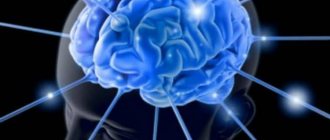Epileptiform seizures or epilepsy is a chronic disease caused by a malfunction of brain cells. In a healthy state, neurons, that is, brain cells, are involved in transmitting signals using electrical impulses. If epilepsy develops, the process of regulation of such impulses and their transmission between brain cells is disrupted. As a consequence, a strong electrical discharge occurs in the cortex, causing a convulsive attack.
A type of pathology is partial or focal epilepsy in children and adults, in which increased brain activity is localized in a clearly limited area of the organ. In most cases, a focal attack has a secondary etiology, so treatment primarily consists of eliminating the causative factor.
The International Classification of Diseases 10th revision (ICD 10) assigned the disease code G40.2.
Partial (focal) epilepsy: what is it?
Partial epilepsy is a form of neurological disorder caused by focal damage to the brain in which gliosis develops (the process of replacing one cell with another). The disease at the initial stage is characterized by simple partial seizures. However, over time, focal (structural) epilepsy provokes more serious phenomena.
This is explained by the fact that at first the nature of epileptic attacks is determined only by the increased activity of individual tissues. But over time, this process spreads to other areas of the brain, and foci of gliosis cause more severe phenomena in terms of consequences. In complex partial seizures, the patient loses consciousness for some time.
The nature of the clinical picture of a neurological disorder changes in cases where pathological changes affect several areas of the brain. Such disorders are referred to as multifocal epilepsy.
In medical practice, it is customary to distinguish 3 areas of the cerebral cortex that are involved in epileptic seizures:
- Primary (symptomatic) zone. Here, discharges are generated that provoke the onset of seizures.
- Irritative zone. The activity of this part of the brain stimulates the area responsible for causing seizures.
- Zone of functional deficiency. This part of the brain is responsible for the neurological disorders characteristic of epileptic seizures.
The focal form of the disease is detected in 82% of patients with similar disorders. Moreover, in 75% of cases, the first epileptic seizures occur in childhood. In 71% of patients, the focal form of the disease is caused by trauma received at birth, infectious or ischemic brain damage.
Temporal lobe epilepsy
A common form of all symptomatic epilepsy (30-35%). The debut is celebrated at different ages (usually school age). Common causes: consequences of hypoxic-ischemic encephalopathy in the form of gliosis, congenital malformations (cortical dysplasia), arachnoid cysts, consequences of previous encephalitis, formation of hippocampal sclerosis. Seizures may occur in one patient with or without loss of consciousness. The attacks are long - 1-2 minutes. Vegetative manifestations, mental and sensory symptoms are present throughout the attack or only at the beginning in the form of an aura, then the focal attack continues with impaired consciousness with bilateral tonic-clonic convulsions. There are two forms of temporal lobe epilepsy depending on the epileptogenic focus: medial (amygdala-hypocampal) and lateral (neocortical) epilepsy.
Medial (amygdala-hypocampal) epilepsy accounts for 65% of all temporal lobe epilepsies and is caused by the presence of a focus in the medial parts of the temporal lobe. The cause is hypocampal atrophy, often in patients who had complex febrile seizures before the age of 3 years, especially prolonged unilateral attacks (in 40% of cases). After a 5-6-year period of remission, focal frequent resistant attacks begin, that is, chronic epilepsy develops.
The clinical basis of this subtype of epilepsy is:
- focal attacks without impairment of consciousness - isolated aura (vegetovisceral, olfactory and gustatory hallucinations), mental phenomena - sleep state, depersonalization, derealization, fear, affect, joy, oroalimentary automatisms with preserved consciousness, dystonic position of the contralateral hand, in the ipsilateral hand there may be simple automatisms;
- focal seizures with isolated loss of consciousness and automatisms without seizures (dialeptic seizures).
Lateral (neocortical) epilepsy is characterized by:
- auditory hallucinations
- visual vivid hallucinations (panoramic views)
- vegetative attacks (non-systemic dizziness, “temporal syncope” - a slow fall without trial with dystonic alignment of the limbs, automatisms)
- paroxysmal sensory aphasia.
In addition to frequent seizures, with gross focal changes in the brain substance, children have a neurological deficit contralateral to the lesion (paresis), emotional and intellectual disorders.
EEG characteristics:
- 50% of patients have a normal EEG between attacks; the required research standard is invasive electrodes;
- 30% of patients experience epipaternes between attacks;
- with medial epilepsy - changes in the anterior bone leads;
- EEG lesions may not coincide with the morphological lesion on magnetic resonance imaging (MRI) - the formation of a “mirror” lesion;
- characteristic EEG phenomenon at the onset - regional slowdown of activity continues;
- provocation - sometimes sleep deprivation;
- overnight EEG shows 65% of changes between attacks.
Interictal EEG shows anterior temporal focus of commissures, paroxysmal theta rhythm.
Characteristics of changes on MRI of the brain in medial epilepsy - hippocampal atrophy, increased signal on T2 from the hippocampus. Hippocampal sclerosis is progressing.
Treatment is surgical. The prognosis after surgical treatment is good. Drug treatment is complex and not always effective; Polytherapy is often used.
Classification and reasons
Researchers distinguish 3 forms of focal epilepsy:
- symptomatic;
- idiopathic;
- cryptogenic.
It is usually possible to determine what it is in relation to symptomatic temporal lobe epilepsy. With this neurological disorder, areas of the brain that have undergone morphological changes are clearly visualized on MRI. In addition, with localized focal (partial) symptomatic epilepsy, the causative factor is relatively easily identified.
This form of the disease occurs against the background of:
- traumatic brain injuries;
- congenital cysts and other pathologies;
- infectious infection of the brain (meningitis, encephalitis and other diseases);
- hemorrhagic stroke;
- metabolic encephalopathy;
- development of a brain tumor.
Also, partial epilepsy occurs as a consequence of birth injuries and fetal hypsoxia. The possibility of developing a disorder due to toxic poisoning of the body cannot be ruled out.
In childhood, seizures are often caused by impaired maturation of the cortex, which is temporary and goes away as the person grows older.
Idiopathic focal epilepsy is usually classified as a separate disease. This form of pathology develops after organic damage to brain structures. More often, idiopathic epilepsy is diagnosed at an early age, which is explained by the presence of congenital brain pathologies in children or a hereditary predisposition. It is also possible to develop a neurological disorder due to toxic damage to the body.
The appearance of cryptogenic focal epilepsy is spoken of in cases where the causative factor cannot be identified. Moreover, this form of the disorder is secondary.
Autosomal dominant frontal lobe epilepsy
The CHRNA4, CHRNA2, and CHRNB2 genes are localized in loci 20q13, 8q, 1p21, respectively. This form of idiopathic epilepsy most often begins between the ages of 7 and 12 years. Night attacks are typical (after falling asleep, 2-3 hours before waking up). The onset occurs with vocalization (usually a cry), while the eyes are open. The nature of the attacks is simple and complex partial.
The clinical picture of attacks is characterized by polymorphism - complex motor acts: the child sits up, scratches his nose, scratches his head, makes grimaces, chews, gets on all fours, rocks, makes pedaling or boxing movements. In 70% of cases there may be an aura (unpleasant sounds, generalized chills, dizziness) - the child wakes up. The duration of the attack is up to 1 minute. There may be several attacks during the night. With this form of epilepsy there is a tendency towards seriality and a “light interval” (no seizures for 2-3 months). The examination does not reveal changes in the neurological status, intelligence and speech.
EEG characteristics:
- main background - no changes;
- in a state outside sleep - without epileptic phenomena;
- The main diagnostic technique is nighttime EEG video monitoring, during which regional activity in the frontal and frontotemporal leads is recorded.
Treatment is complex, often effective polytherapy: carbamazepine, valproic acid drugs, topiramate, lamotrigine, levetiracetam or a combination of basic drugs.
This form of epilepsy requires a differential diagnosis with symptomatic frontal epilepsy, in which the EEG shows a slowdown in the basic rhythm, the neurological status is without focal changes, and neuroimaging shows organic changes in the brain substance. A differential diagnosis should also be made from parasomnias, in which there are no epileptic patterns on the EEG.
2. Symptomatic (structural/metabolic) epilepsy
Symptoms of partial seizures
The leading symptom of epilepsy is considered to be focal seizures, which are divided into simple and complex. In the first case, the following disorders are noted without loss of consciousness:
- motor (motor);
- sensitive;
- somatosensory, supplemented by auditory, olfactory, visual and gustatory hallucinations;
- vegetative.
Prolonged development of localized focal (partial) symptomatic epilepsy leads to complex seizures (with loss of consciousness) and mental disorders. These seizures are often accompanied by automatic actions that the patient has no control over and temporary confusion.
Over time, the course of cryptogenic focal epilepsy can become generalized. With such a development of events, an epileptic attack begins with convulsions affecting mainly the upper parts of the body (face, arms), after which it spreads lower.
The nature of the seizures varies depending on the patient. In the symptomatic form of focal epilepsy, a person’s cognitive abilities may decrease, and in children there is a delay in intellectual development. The idiopathic type of the disease does not cause such complications.
Foci of gliosis in pathology also have a certain influence on the nature of the clinical picture. Based on this feature, types of temporal, frontal, occipital and parietal epilepsy are distinguished.
Frontal lobe lesion
When the frontal lobe is damaged, motor paroxysms of Jacksonian epilepsy occur. This form of the disease is characterized by epileptic seizures during which the patient remains conscious. Damage to the frontal lobe usually causes stereotypical short-term paroxysms, which later become serial. Initially, during an attack, convulsive twitching of the muscles of the face and upper limbs is noted. They then spread to the leg on the same side.
In the frontal form of focal epilepsy, there is no aura (phenomenon that foreshadows an attack).
Turning of the eyes and head is often observed. During seizures, patients often make complex movements with their arms and legs and become aggressive, shouting words or making strange noises. In addition, this form of the disease usually manifests itself during sleep.
Temporal lobe lesion
This localization of the epileptic focus of the affected area of the brain is the most common. Each attack of a neurological disorder is preceded by an aura characterized by the following phenomena:
- abdominal pain that cannot be described;
- hallucinations and other signs of visual impairment;
- olfactory disorders;
- distortion of the perception of surrounding reality.
Depending on the location of the focus of gliosis, attacks may be accompanied by a short-term loss of consciousness, which lasts 30-60 seconds. In children, the temporal form of focal epilepsy causes involuntary screams, in adults – automatic movements of the limbs. At the same time, the rest of the body freezes completely. Attacks of fear, depersonalization, and a feeling that the current situation is unreal are also possible.
As the pathology progresses, mental disorders and cognitive impairments develop: memory impairment, decreased intelligence. Patients with the temporal form become conflicted and morally unstable.
Parietal lobe lesion
Foci of gliosis are rarely detected in the parietal lobe. Lesions in this part of the brain are usually observed with tumors or cortical dysplasia. Seizures cause tingling sensations, pain and electrical discharges that shoot through the hands and face. In some cases, these symptoms extend to the groin area, thighs and buttocks.
Damage to the posterior parietal lobe causes hallucinations and illusions, characterized by patients perceiving large objects as small and vice versa.
Possible symptoms include disturbances in speech functions and spatial orientation. In this case, attacks of parietal focal epilepsy are not accompanied by loss of consciousness.
Occipital lobe lesion
Localization of foci of gliosis in the occipital lobe causes epileptic seizures, characterized by decreased quality of vision and oculomotor disorders. The following symptoms of an epileptic seizure are also possible:
- visual hallucinations;
- illusions;
- amaurosis (temporary blindness);
- narrowing of the field of view.
With oculomotor disorders the following are noted:
- nystagmus;
- fluttering eyelids;
- miosis affecting both eyes;
- involuntary rotation of the eyeball towards the focus of gliosis.
Along with these symptoms, patients are bothered by pain in the epigastric region, pale skin, migraine, and attacks of nausea with vomiting.
Symptoms of brain gliosis
Often, gliosis is not accompanied by characteristic manifestations. But in case of pronounced development of the process, the following symptoms may appear:
- Jumps in blood pressure during the day;
- Intense headache;
- Frequent attacks of dizziness;
- Increased fatigue, even after rest;
- Impaired coordination of movements;
- Decreased memory and intellectual abilities;
- Speech function problems;
- Paresis or paralysis;
- Hearing or vision disorders;
- Mental balance disorders.
The occurrence of focal epilepsy in children
Partial seizures occur at any age. However, the appearance of focal epilepsy in children is mainly associated with organic damage to brain structures, both during intrauterine development and after birth.
In the latter case, the rolandic (idiopathic) form of the disease is diagnosed, in which the convulsive process involves the muscles of the face and pharynx. Before each epileptic attack, numbness of the cheeks and lips, as well as tingling in these areas, are noted.
Most children are diagnosed with focal epilepsy with electrical status of slow-wave sleep. In this case, the possibility of a seizure occurring during wakefulness cannot be excluded, which causes impaired speech function and increased salivation.
More often, it is in children that the multifocal form of epilepsy is detected. It is believed that initially the focus of gliosis has a strictly localized location. But over time, the activity of the problem area causes disturbances in the functioning of other brain structures.
Multifocal epilepsy in children is mainly caused by congenital pathologies.
Such diseases cause metabolic disorders. Symptoms and treatment in this case are determined depending on the location of the epileptic foci. Moreover, the prognosis for multifocal epilepsy is extremely unfavorable. The disease causes a delay in the development of the child and cannot be treated with medication. Provided that the exact localization of the focus of gliosis is identified, the final disappearance of epilepsy is possible only after surgery.
Late-onset childhood occipital epilepsy (Gastaut syndrome)
Attacks are recorded more often than with Panagiotopoulos syndrome (once a week - once a month). The disease begins between the ages of 3 and 15 years, with a maximum at 8 years. The clinical core is simple partial sensory attacks - visual hallucinations in the peripheral visual field, hemianoptic hallucinations, illusions with a sensation of pain in the eyes, blinking, turning the eyes and head in the direction opposite to the epileptogenic focus. The duration of attacks is seconds to minutes. At the end of the attack, complaints of severe headache with vomiting are typical (in 50% of patients). There may be secondary generalization with tonic-clonic seizures. With Panayotopoulos and Gastaut syndromes, there are no changes in assessing the neurological status and cognitive sphere of the child.
- DESD in the occipital leads in 90% of patients between attacks;
- the main background is unchanged;
- 30% of children may have changes in the temporal leads;
- typical: disappearance of the pathological pattern when opening the eyes; high photosensitivity;
- night EEG video monitoring: in the stage of slow sleep - an increase in DESD complexes (early diagnosis of the disease) normalization of the EEG picture before reaching the age of 15 years.
In treatment, the principle of MONOTHERAPY is used with one of the following drugs - carbamazepine, valproic acid preparations, oxcarbazepine, topiramate, lamotrigine.
These forms of epilepsy are also considered benign. Complete remission with Panagiotopoulos syndrome occurs before the age of 9 years, with Gastaut syndrome - 15 years.
Diagnostics
Diagnosis of symptomatic focal epilepsy begins with identifying the causes of partial seizures. To do this, the doctor collects information about the condition of close relatives and the presence of congenital (genetic) diseases. Also taken into account:
- duration and nature of the attack;
- factors that caused the seizure;
- the patient's condition after the end of the seizure.
The basis for diagnosing focal epilepsy is an electroencephalogram. The method allows you to identify the localization of the focus of gliosis in the brain. This method is effective only during periods of pathological activity. At other times, stress tests with photostimulation, hyperventilation, or sleep deprivation are used to diagnose focal epilepsy.
Malignant migrating focal seizures of early childhood (Coppola-Dulac syndrome)
A relatively new form of focal epilepsy.
characteristic:
- etiology unknown (probably genetic origin);
- onset age 6 months;
- normal development at debut;
- motor and intellectual regression;
Seizures:
- focal motor;
- bilateral tonic-clonic;
- vegetative (apnea, cyanosis)
- in the form of series and clusters (2-5 days), short remissions.
progressive microcephaly; on the EEG - a typical focal pattern in various leads; MRI is normal.
Treatment: first-line drugs - topiramate, lamotrigine, second - valproic acid, levetiracetam.
Treatment
Focal epilepsy is treated primarily with medications. The list of drugs and dosage are selected individually based on the characteristics of the patients and epilepsy attacks. For partial epilepsy, anticonvulsants are usually prescribed:
- valproic acid derivatives;
- "Carbamazepine";
- "Phenobarbital";
- "Levetiracetam";
- "Topiramate."
Drug therapy begins with taking these drugs in small doses. Over time, the concentration of the drug in the body increases.
Additionally, treatment is prescribed for the concomitant disease that caused the neurological disorder. Drug therapy is most effective in cases where foci of gliosis are localized in the occipital and parietal regions of the brain. With temporal lobe epilepsy, after 1-2 years, resistance to the effects of drugs develops, which causes another relapse of epileptic seizures.
In case of multifocal form of neurological disorder, as well as in the absence of effect from drug therapy, surgical intervention is used. The operation is performed to remove tumors in the structures of the brain or the focus of epileptic activity. If necessary, adjacent cells are excised in cases where they are found to be causing seizures.
Negative consequences
If treatment for focal epilepsy is started promptly, one can hope for a favorable prognosis. Negative consequences often occur with severe generalized seizures. Death is possible if injured during a fall, due to respiratory arrest (with spastic changes in the respiratory muscles), inhalation of blood or saliva from the mouth. A prolonged attack causes an increase in the load on the cardiovascular system, the development of brain hypoxia, increasing the risk of coma or death.
During pregnancy
You should not neglect going to the doctor and his appointments if a woman with chronic epilepsy managed to get pregnant. In general, the pathology does not have a negative impact on pregnancy, but an attack can cause premature termination of pregnancy. There are cases when pregnancy becomes a triggering factor for the development of epilepsy.
Due to hormonal changes and increased stress on the body, there is a manifestation or exacerbation of processes that are in a “dormant” state, including epiactivity. In medicine, there is such a term as “gestational epilepsy,” in which seizures develop only during pregnancy and spontaneously disappear after delivery.
When planning a pregnancy, many women wonder: will the disease be passed on to their children, that is, is there a hereditary predisposition? Of course, the hereditary factor plays a role in the development of focal epilepsy, but it is impossible to give a 100% guarantee that the offspring will develop the disease.
Therapy for pathology during gestation is prescribed on an individual basis, taking into account developmental characteristics. Of course, during pregnancy, many anticonvulsants are prohibited for use, as they have a teratogenic effect. However, in cases of severe epilepsy and the risk of developing generalized seizures, they are still prescribed, but in a lower dosage than for other patients.
While taking anticonvulsants, breastfeeding is not stopped, since the child’s contact with the medications occurred during the prenatal period. If lethargy or chronic intoxication occurs, the baby can be transferred to artificial feeding.
Forecast
The prognosis for focal epilepsy depends on many factors. The localization of foci of pathological activity plays an important role in this. The nature of partial seizures of epilepsy also has a certain influence on the likelihood of a positive outcome.
A positive outcome is usually observed in the idiopathic form of the disease, since cognitive impairment is not caused. Partial seizures often disappear during adolescence.
The outcome of the symptomatic form of the pathology depends on the characteristics of the damage to the central nervous system. The most dangerous situation is when tumor processes are detected in the brain. In such cases, there is a delay in the child's development.
Brain surgeries are successful in 60-70% of cases. Surgical intervention significantly reduces the frequency of epileptic attacks or completely relieves the patient of them. In 30% of cases, several years after surgery, any phenomena characteristic of this disease disappear.
Neuron-glia interaction in the pathogenesis of epilepsy
Since the time of Hippocrates, epilepsy has been a terrifying disease that has also been associated with possession. However, since the advent of electroencephalography (EEG) in 1929, this disease has acquired a pathophysiological explanation in the form of the appearance of hypersynchronous impulses from a focus of neurons in the central nervous system (CNS). According to the current international standard, to make a diagnosis of epilepsy, a minimum of 2 episodes of unprovoked seizures occurring more than 24 hours apart is required, or 1 episode plus the likelihood of further seizures, calculated by the risk of recurrence after two unprovoked seizures occurring within the next 10 years, or a verified diagnosis of epileptic syndrome.
The discovery of phenobarbital in 1912 became the starting point in the treatment of epilepsy: the drug was effective in 2/3 of patients. However, the remaining third remained resistant to treatment, which gave rise to research into the pathogenesis of epilepsy: the study of hypersynchrony and changes in neuronal activity. Neuronal activity is regulated by neurotransmitters, their metabolism, biochemistry, and communication with ion channels. There have been attempts to link epilepsy to the breakdown of a specific gene, but the disease is generally polygenic.
Various biological changes in the central nervous system involved in epileptogenesis have been described: gliosis, excessive inflammation, disruption of the permeability of the blood-brain barrier (BBB), neurodegeneration, aberrant neurogenesis, axonal and dendritic plasticity, changes in the neuronal circuit, structural and functional changes in ion channel receptors, reorganization of the extracellular matrix, etc. However, one must understand that previously researchers studied mainly neuronal activity and the contribution of neurons to epileptogenesis. Below, we discuss some of these factors in more detail, discussing the contribution of glia and their influence on neurons during seizure pathogenesis.










